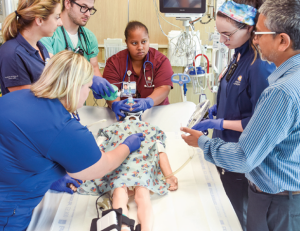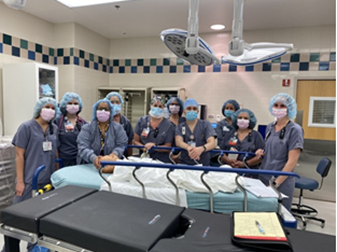simulation education program
simulation mission and vision | simulation scenarios and policies | meet our staff
what is the simulation education program?

Dayton Children’s offers a new simulation education program as part of our commitment to provide care that is always above and beyond for our kids. Dayton Children’s is committed to providing safe patient care and providing our staff with the best continuing education possible.
The simulation education program will provide simulated education anywhere from task training and low fidelity simulation scenarios to high fidelity simulation scenarios, providing our staff a safe space to practice and learn essential skills such as tasks, procedures, communication, resource, and medical management.
defining types of simulation
Standardized patients: Trained volunteers who portray patient histories for physical exams. This method is best for teaching and assessing information gathering skills, physical exam technique, information giving and counseling, informed consent, and mass-casualty scenarios.

High fidelity manikins: Computerized manikins that respond physiologically to simulated care. These are best utilized to teach and assess emergency skills, team skills, and decisions under stress i.e., mock codes, PALS, NRP, ACLS, PFCCS.
Low fidelity manikins: Manikins that physically represent a patient but cannot respond physiologically to simulated care. These are best utilized to teach quick assessment skills, and minor procedures such as intravenous placement and intubation.
Task trainers: Representations of body parts for procedural skills training such as intubation, vascular access, lumbar puncture, ultrasound imaging, minor surgeries, and laparoscopic techniques.
Virtual reality: Computer simulations designed to teach and evaluate thinking skills, decision-making, and high-risk procedures.
Video review: Video capture and analysis of a simulation to review for team performance and assessment of skills.
where will simulations occur?
We will be expanding upon current simulation training to include more robust and widespread opportunities. When appropriate, simulation training will occur in the shared space on 3W. Census dependent and scenario appropriate training will occur in rooms 331 and 332 which have been updated to include high-definition cameras for the simulation operator to view the scenario and program the simulated patient to respond appropriately. Additionally, the rooms have been outfitted with microphones to allow the operator to provide real-time feedback to the leaders and allow the simulated patient to have their own voice.
how do I schedule simulations for my staff?
Scheduling simulation education can be completed by clicking the button below
Once submitted, the simulation sducation staff will reach out to the leader to review the request and determine next steps.
Please reach out to Greg Bader, BaderG@childrensdayton.org for more information and questions.

